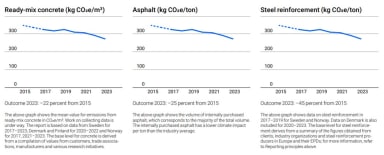Sustainability targets and outcome
NCC has Group-wide targets within two impact areas: Health and safety and Climate and energy. Furthermore, the business areas set operations-specific sustainability targets.
The sustainability targets are part of NCC’s strategy, and are followed up and reported annually. In our annual report, you can read more about this year’s outcome and how we work towards achieving the targets.
Our long-term goals are complemented by a selection of the UN’s global sustainable development goals. Learn more about how NCC is affected by these global goals here.
Health and safety
NCC shall have a safe, secure and healthy work environment. NCC's long-term objective is to completely eliminate accidents with a serious or fatal outcome, and to reduce the total number of accidents.
| Key performance indicator | Target 2023 |
Outcome 2023 | Interim target 2024 | Target 2026 |
| LTIF4* |
2.75 | 4.0 | 2.5 | 2.0 |
*Work related accidents with over four calendar days absence per one million work hours for NCC’s employees.

Climate and energy
NCC strives to eliminate GHG emissions from the entire value chain, increase energy efficiency and enable adaption to climate change.
NCC's own emissions
| Key performance indicator | Target | Outcome 2023 |
| Reduction of CO2e tons/SEK M (Scope 1 and 2). |
-60 percent by 2030 compared with base year 2015 |
-56 percent |
Scope 1: Direct emissions related to for example fuel consumption in asphalt plants, and from own vehicles and machinery.
Scope 2: Indirect emissions related to the production of electricity, district heating and district cooling used in the operations.
NCC's value chain emissions
| Key performance indicator | Target |
| Reduction of kilograms of CO2e/purchased volume from concrete, asphalt, steel, and transportation (Scope 3). | -50 percent by 2030 compared with base year 2015 |
Scope 3: Indirect emissions from the value chain, for example purchased materials.
Outcome 2023
| Concrete1) | Asphalt1) | Steel reinforcement1) | Transportation2) |
| -22 percent |
-25 percent | -45 percent | − |
1) To date, this metric refers only to ready-mix concrete, internally purchased asphalt and steel reinforcement.
2) Emissions from transportation are reported for the first time in 2023 and thus no comparative figures are available.

